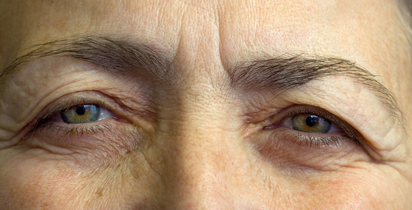
Saccade is a rapid movement of the eye between fixation points. They range in amplitude from small movements to much larger movements. Saccades can be horizontal or vertical. The study of this type of eyelid movement can help to examine the conditions that affect eyelid function, such as blepharoptosis, cicatricial lagophthalmos, lower eyelid entropion, and Graves’ upper eyelid retraction.
There have been very few studies that considered the effect of aging on eyelid saccades.
A study published in the Brazilian Journal of Medical and Biological Research clearly shows the effect of aging on the metrics of upper and lower eyelid saccades. For this study, 60 patients were divided on the basis of age into a younger group (20-30 years) and an older group (60-91 years). To determine the effect of aging, researchers measured the eyelid movement of the young and old groups, each comprising 30 subjects without history of eye or eyelid surgery. The upper and lower eyelid saccades of these subjects were analyzed using computed image analysis. Amplitude and peak velocity were used to compare the effect of age on the saccades.
Highlights of the study include:
- For the upper eyelid there was no difference in amplitude between the saccades of the old and young subjects. The saccades of the older subjects were slower than that of the young group. This decrease in velocity was not followed by any change in the functions relating velocity and amplitude to time. The linear connection between velocity and amplitude shown in young subjects was seen in older subjects as well.
- Aging had a completely different effect on the dynamics of the lower eyelid. The saccade amplitude of the older group was much greater than that of the young group. Just as in the case of the upper eyelid, the relationship between velocity and amplitude and time were normal. A linear relationship was found between velocity and amplitude. The mean velocity was also seen to be higher in the older group.
With aging, the collagen and other tissues deteriorate resulting in the reduction of the levator muscle aponeurosis in the upper eyelid. This results in aponeurotic ptosis. Consequently, there is less tension on the tarso-ligament system of the upper eyelid and reduced velocity of the upper eyelid saccades.
Aging is said to bring about attenuation of the lower eyelid retractors. The reverse lower eyelid ptosis is distinguished by reduced distance from the lower eyelid margin to the pupil. The older group in the study presented a smaller average mid-pupil eyelid distance than the young group, indicating lower eyelid ptosis.
The researchers believe that the key source of the lower eyelid movement is the rotation of the eye that pushes up the entire complex or orbital fat, inferior fomix and lower eyelid retractors. The transmission of force to the lower eyelid is not eliminated with age, as proved by the fact that the amplitude of the lower eyelid saccades was more in the older group. If eye rotation is the cause of the tension generated on the lower eyelid, then a sagging lid will have more mobility than a tight one. The attenuation of the lower eyelid retractors may partly be responsible for higher mobility of the lid.
Though none of the elderly subjects had entropion (eyelid turns inward), the data provided by the study clearly supports investigators who stress the importance of correcting the horizontal laxity in lower eyelids for patients with entropion.
Lower lid entropion is a common condition in elderly individuals; the prevalence increases steadily with age. It can cause discomfort from contact between the eyelashes and the surface of the eye. This condition can be repaired through lower eyelid surgery that tightens the abnormal muscle. The success of this repair depends on good surgical technique. Lateral canthotomy, a step in common eyelid procedures is performed for eyelids with extreme horizontal laxity.